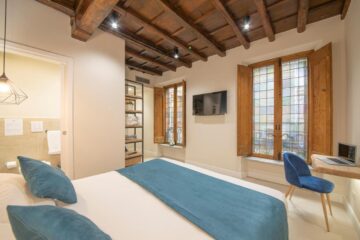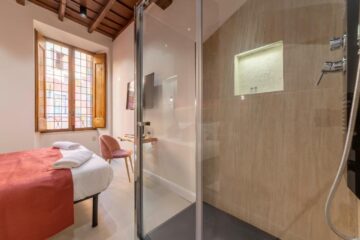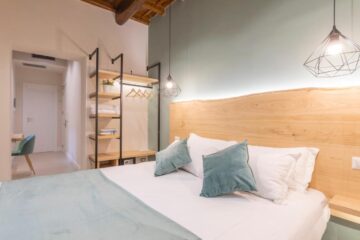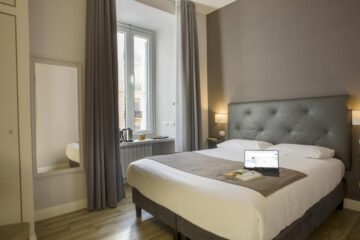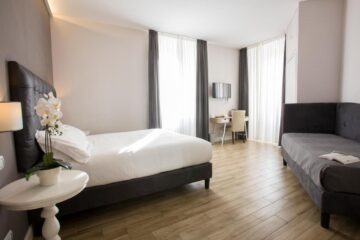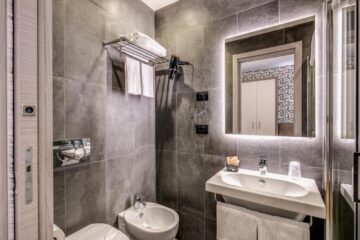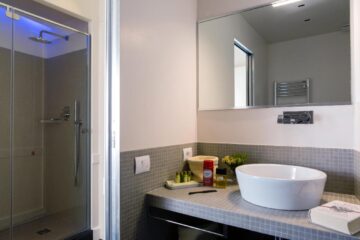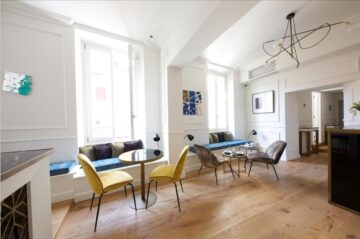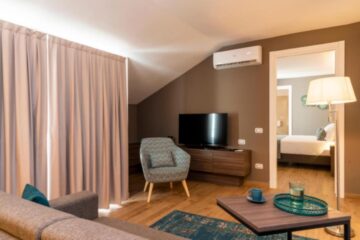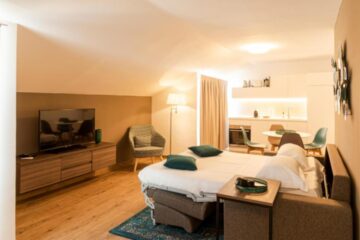Rome offers a blend of history, culture, and modern amenities for digital nomads and remote workers, with plenty of co-working spaces and cafes offering good Internet connection. The city’s slower pace, friendly locals, delicious food and rich cultural experiences provide a unique work-life balance in Italy.
Nomad Score: 6/10 ・ Cost of living: $2200/month ・ Internet speed: 30 Mbps
▶ Campo de’ Fiori 34 – Standard Double Room
▶ Colosseo Prestige Rooms – Standard Double, Twin or Triple Room
▶ MyNavona – Superior Double or Twin Room with City View
▶ Parisii Luxury Relais Rome – Deluxe Room
▶ Sant’Ivo Apartments – One-Bedroom Apartment
▶ Aurelia Antica Suites & Apartments – Apartment with Terrace
This guide should help you navigate the essential aspects of living and working as a digital nomad in Rome, balancing productivity with Rome’s vibrant cultural life:
1. Internet and Connectivity
- Wi-Fi: Rome’s internet infrastructure is improving, but speeds can vary. Many cafes, co-working spaces, and accommodations provide free Wi-Fi, though it’s a good idea to check speeds beforehand.
- Mobile Plans: Companies like TIM, Vodafone, and WindTre offer prepaid SIM cards with 4G or 5G data. These plans are affordable and easy to set up for staying connected on the go.
2. Co-working Spaces
Rome has several co-working spaces, though not as abundant as in some major digital nomad hubs:
- Regus Rome: A popular co-working chain with multiple locations offering professional office setups.
- Talent Garden Ostiense: Located in the trendy Ostiense district, this space is perfect for entrepreneurs and freelancers.
- Cowo360: Located near the city center, offering flexible memberships and a creative, dynamic atmosphere.
- SPACES EUR: A modern co-working space in a business district, ideal for a more corporate environment.
3. Cost of Living
- Accommodation: Rent in central Rome is higher than in other parts of Italy. A one-bedroom apartment in the historic center can cost around €1,000-€1,500 per month, but staying in areas like Testaccio or San Giovanni can be more affordable.
- Food: Rome has affordable grocery shopping options and countless inexpensive trattorias and pizzerias. Expect to spend around €10-€15 for a meal at an affordable restaurant, or you can explore fresh food markets like Campo de’ Fiori or Mercato Testaccio.
- Co-working: Monthly co-working memberships in Rome can range from €150 to €300 depending on the location and services.
4. Where to Stay
- Trastevere: A charming area with cobblestone streets, lively nightlife, and a young expat community.
- San Giovanni: A quieter, more residential area with lower rents and easy metro access.
- Testaccio: Known for its authentic Roman atmosphere and proximity to good food markets and bars.
- Ostiense: A trendy, up-and-coming neighborhood with a growing tech scene and access to modern co-working spaces.
5. Transportation
- Public Transport: Rome has a metro, buses, and trams, though it can be inconsistent. Consider getting a monthly ATAC transport pass for unlimited travel on public transport (€35 per month).
- Bicycles: Biking is growing in popularity, but the city’s historic streets and traffic can make it a challenge. Rome is also hilly, so electric scooters (like Lime) might be a better option.
- Walking: Many of Rome’s key neighborhoods and landmarks are walkable, and it’s the best way to explore the city’s hidden gems.
6. Work-Friendly Cafes
- Anticafe: A time-based cafe offering good Wi-Fi, where you pay for time spent rather than drinks.
- Barnum Cafe: A cozy spot near Campo de’ Fiori with reliable Wi-Fi and a relaxed atmosphere.
- Faro: A specialty coffee shop perfect for work sessions, known for its great coffee and relaxed environment.
- Ex Circus: A popular cafe near Piazza Navona with a laid-back vibe and work-friendly setup.
7. Visa and Legal Information
- Schengen Visa: Non-EU citizens can stay up to 90 days on a Schengen tourist visa. For longer stays, look into Italy’s freelancer visa or the EU Blue Card for skilled workers. Digital nomads might also explore the new visa for remote workers Italy introduced.
8. Networking and Community
Rome has a small but growing digital nomad community:
- Meetups: Meetup.com hosts various events in Rome, from language exchanges to startup meetups.
- Expat Groups: Join Facebook groups like “Expats Living in Rome” or “Rome Digital Nomads” to connect with locals and other digital nomads.
- Nomad List: Rome ranks as a slower-paced digital nomad hub, great for those balancing work with a desire to immerse in history and culture.
9. Local Attractions and Leisure
- Historical Sites: Explore iconic landmarks like the Colosseum, the Roman Forum, and the Vatican. There’s no shortage of inspiration in Rome’s rich history.
- Parks: Rome offers plenty of green spaces, like Villa Borghese and Villa Doria Pamphili, ideal for breaks and fresh air.
- Cultural Activities: Enjoy art galleries, museums, and live performances. Don’t miss the Galleria Borghese, Vatican Museums, and local theaters.
10. Health and Safety
- Healthcare: Italy has a public healthcare system, but if you’re not an EU citizen, you’ll need private health insurance for your stay.
- Safety: Rome is generally safe, but petty crime like pickpocketing can occur, especially in tourist-heavy areas like Termini Station and near major attractions. Always be mindful of your belongings.
Bonus Tips
- Language: English is widely spoken in tourist areas, but learning basic Italian phrases will go a long way.
- Weather: Summers are hot, so aim for early morning work hours and enjoy the cooler evenings. Winters are mild, but pack accordingly.
- Cuisine: Take advantage of Rome’s incredible food scene—from traditional Roman dishes like carbonara and cacio e pepe to its famed gelaterias.
